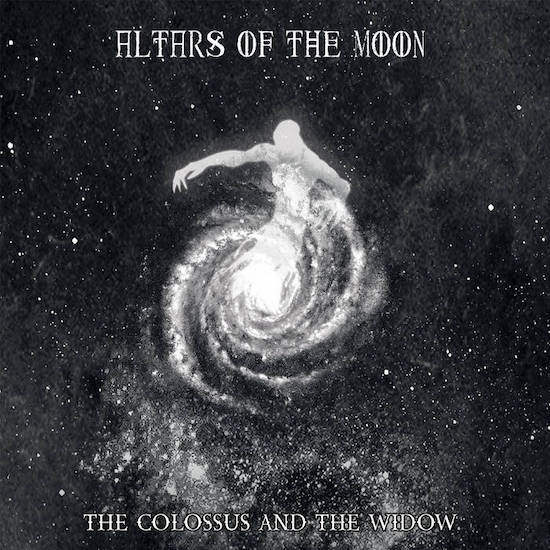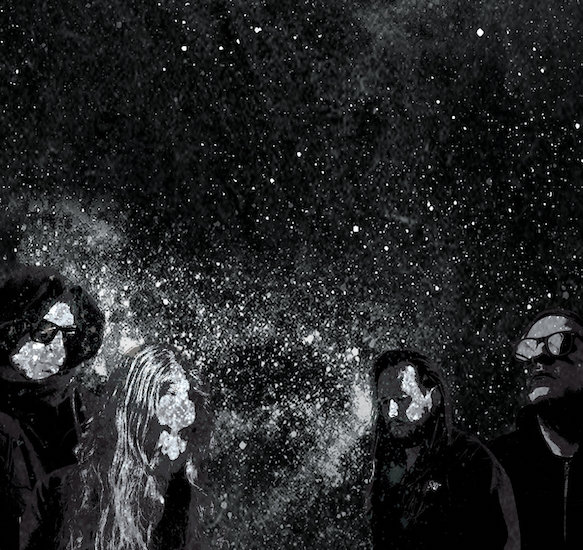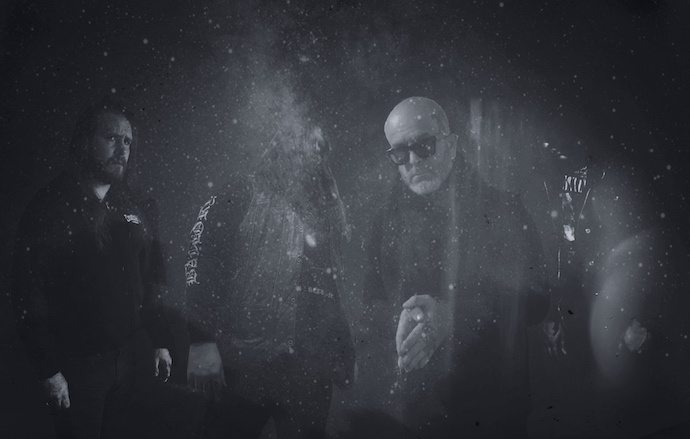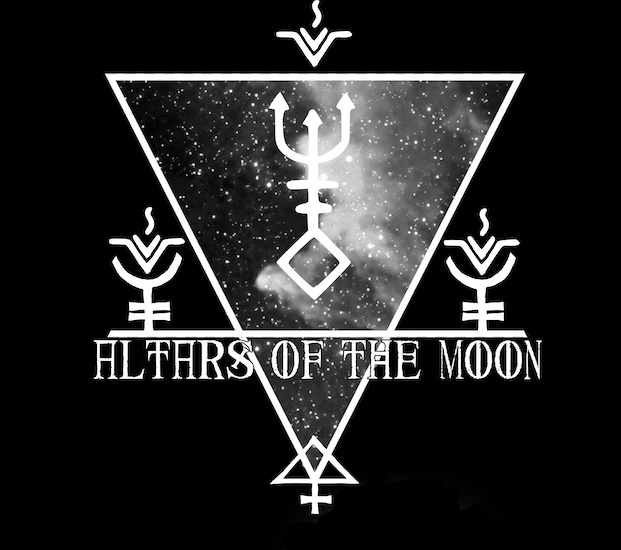
Released in the summer of 2021, Brahmastra was the debut album of Altars of the Moon. It first turned some heads because of the identities of the people who made it: Nathan Verschoor (Uada), Jeff Wilson (Chrome Waves, Deeper Graves, ex-Nachmystium), and Heath Rave (Lotus Thrones, ex-Wolvhammer). It probably turned heads again when it became evident that the music was several big steps away from what might have been expected given the nature of the participants’ main musical endeavors.
Like other collaborations, this one was born in lockdown times, one of covid’s precious few silver linings. As a plague child, some might have expected it would quickly perish, a one-and-done union of talents. But time doesn’t heal all wounds, nor does it always still restless minds or silence voices. As it turns out, Altars of the Moon had something more to say.
And so now we’re on the verge of Disorder Recordings releasing a second Altars of the Moon album, this one named The Colossus and The Widow. The three collaborators came together again by long distance — Rave on vocals, Verschoor on guitars and synths, and Wilson on bass, guitar, and synth — but this time they were joined by another notable name, Alan Cassidy (The Black Dahila Murder), on drums. In addition, the new record features guest appearances on saxophone by Bruce Lamont (Yakuza) and on trumpet by Mac Gollehon (Duran Duran, David Bowie).
We’re now putting the results before you in full, preceded by our own thoughts as usual but also by these from Heath Rave:

It’s been a long moment since I’ve listened to this front to back and I decided to sit back and listen without judgement of performance bias and my own ego. Of the many works of art that I’ve been involved in solely or collaboratively, I’m truly grateful for this one coming back to it with fresh ears upon its release. Getting to work with some of the greatest talents in the world of heavy music is such a privilege, and it really felt collaborative considering the limitations of never being in a room together.
There’s a darkness expressed here that I’ve always wanted to capture in a project. It gives me the same feel as Tiamat’s A Deeper Kind Of Slumber, My Dying Bride’s 34.788%…Complete, or even Samael’s Passage. While I could hear the potential on the first one we did, Brahmastra, I feel like we tapped the cosmic code of avant garde DNA and I was really able to express and push the vocal and lyrical themes of sorrow and man’s ignorance of its microscopic and fragile place in the universe.
If you’ve heard Brahmastra, you’ll have some expectations going into the new one. If you haven’t heard it but did read the quote above, you’ll likely have some others. But, for reasons we’ll explain, it’s best to just clear your head and take in these nine tracks as they come. You might also want to ignore some of the hybridized genre references that have surfaced in write-ups about the album; they’re not fictional but they might still give you the wrong idea about what’s coming.

Brahmastra followed its own path across two ultra-long and emotionally very different songs. In Part 1 it was a glittering astral path of many colors but with a turbulent and earthy undercurrent, like the glorious cosmic visions of hallucinating participants stamping in a shamanistic ritual. As in the music, the vocals revealed contrasts too, singing in gloom-shadowed tones that wouldn’t have been out of place in dark post-punk but also letting the demons loose.
Part 2 also had a dream-like quality, but it was a far darker and more distressing dream, and as futuristic as it was primitive. There, the glimmering audio visions and warping electronics up above were backed by a gnawing and clawing abrasion in the low end and by gut-punching grooves. There, the dismal singing vocals also exploded in distress and muttered in disgust (or so it seemed).
The Colossus And The Widow doesn’t discard the ingredients that made Brahmastra such a stirring yet unnerving experience, but it does some different things with them, and adds to them. And so it travels many more paths than its predecessor, none of them mundane.
The music is again capable of drenching the mind with hallucinogens and then transporting it into a glide path along astral lanes, but if anything the rhythms (when they manifest) are even heavier, even more viscerally potent, and the vocals more forward and piercing, more daunting and haunted, and edged with eeriness in their tones.
Most notable at first is the increased darkness and emotional desolation in the music. At the outset, the album’s first two songs take the darkness of Brahmastra and double-down on it, albeit with a bass-and-drum interplay that becomes riveting.
“The Drift”, in turn, manifests a different kind of darkness, more vast and unearthly, wondrous yet perilous, a rhythm-less prelude to the album’s next steps — which sometimes never touch the ground and at other times powerfully rumble the earth.

As the album proceeds, the instrumentation fashions the wail of ephemeral alien wraiths, providing chilling accompaniment to the stridency of growled and distorted pronouncements and the derangement of screams. The brass instruments play their own role in both the spreading of shadows and the revealing of wonders. And yes, beautiful wonders are revealed, even more so than in the first album, even when, as in “The Longing” (a second rhythm-less and voice-less piece), they usher the mind into moods of wistfulness and melancholy.
Returning to the brass instruments, they become different kinds of wraiths in the mind-bending (and kind of mind-mutilating) experimentation of “The Vestibule”, where the rhythm section is again missing. And after the grim and harrowing heaviness of “First Contact Protocol”, you’ll find another mesmerizing interlude in “The Sentient” before the band torque the tension to the breaking point in “Existence Invalid”… and then drift away into a long cold silence.
The song titles point toward daunting entities and harrowing events in unknown reaches of the cosmos with no regard for the existence or survival of our dwarfish and damaged species. The idea that it would be no great loss if something extinguished all of us, and that nothing else would care, fuels the themes. When it comes to those themes, especially as publicly described by Heath Rave, “bleak” is an understatement.
Yet it’s hard to listen to the album and not imagine dreams of the spectacular, light years removed from the ugliness we wake up to each day. Those sensations can be alien and hostile, but they’re not bleak. Maybe they’re intended as a sign of what we don’t have, and never will have, or a reminder that our egoism is pathetic in the grand scheme of things, but they’re still a counterweight to the gloom that travels with the wonder in the album, side by side.
Well, we’ve contradicted ourselves by asking you to clear your minds and then trying to fill them with all these words. But it’s that kind of album, a thoroughly fascinating and wholly engrossing experience that doesn’t really sound like anything else and won’t leave you as it found you — all these words are just a long-winded way of saying “Thank you”.
The Colossus And The Widow was engineered by Nate Verschoor at Hrimhjarta Studio and Jeff Wilson at Disorder Recordings, with Verschoor handling the design and layout, and Wilson handling the final mix and mastering.
Disorder Recordings will release the album tomorrow (November 17th), digitally and on LP vinyl. Find pre-orders here:
PRE-ORDER:
https://altarsofthemoon.bandcamp.com/album/the-colossus-and-the-widow
ALTARS OF THE MOON:
https://www.instagram.com/altarsofthemoon
DISORDER RECORDINGS:
http://disorder-recordings.com
https://disorder-recordings.bandcamp.com
https://www.instagram.com/disorderdesignco
https://disorderdesignco.bigcartel.com
